June 2022
- English
- 日本語
Carrying on 1,200 Years of Japanese Culinary Tradition
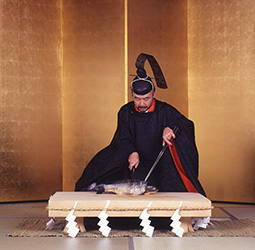
Shijo Takahiko prepares to carve a fish in the Culinary Knife Ceremony 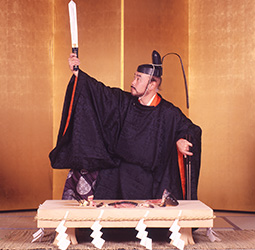
Shijo Takahiko carves the fish in the Culinary Knife Ceremony 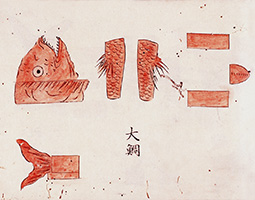
A page from the book that the Shijo family has passed down through the generations showing how to arrange the carved up foods on the carving board 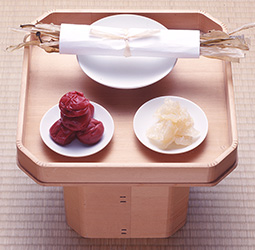
The shokon (first round) of the shiki-san-kon (three formal rounds) featuring umeboshi (pickled plum, bottom left), kurage (jellyfish, bottom right) and awabinoshi (dried abalone) 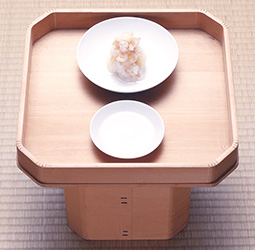
The nikon (second round), a namasu (a dish of finely chopped fish) of funa (crucian carp) with a saucer of vinegar 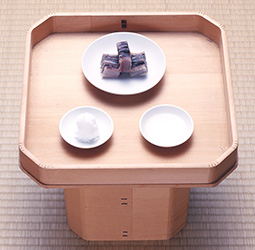
The sankon (third round), a dish of carp sashimi, with saucers of salt and vinegar

The Shijo family of court nobility lineage has been passing down Japanese culinary traditions originating in the Imperial court for some 1,200 years.

When speaking about the origins of traditional Japanese cuisine, there are two important figures considered to be its “founders.” The first is Iwakamutsukari no Mikoto, who is believed to have made namasu (a dish of finely chopped fish that is the forerunner to modern sashimi) by going into the sea to catch skipjack tuna and clams for the Emperor Keiko, who assumed the throne in the mid-first century. The other is Fujiwara no Yamakage (hereinafter, Lord Yamakage), also called Shijo Chunagon. Lord Yamakage was a noble who served the 58th Emperor Koko*, who acceded to the throne in the late ninth century. At the order of Emperor Koko, who had a deep knowledge of cooking, Lord Yamakage is said to have devised the basic cooking methods, manners and rituals associated with food served in the imperial court through a process of trial and error.
“During the Heian period (late eighth century to late twelfth century) when court culture flourished, a great many rituals came to be performed in the imperial court. Among them were rituals in which food was served. These practices carried the meaning of ‘offering meals to the gods.’ The cuisine that developed in the imperial court and noble society around this time is one of the origins of the traditional Japanese cuisine we know today,” says Shijo Takahiko.
Shijo is the 41st head of the Shijo family descended from Lord Yamakage. Over generations spanning some 1,200 years, the Shijo family has passed down the culinary traditions of the imperial court and noble society.
One of these is a culinary practice known as shiki-san-kon (“three formal rounds”) developed during the Heian period. Originally, shiki-san-kon was a practice observed when a court noble would hold a banquet, in which appetizers to be served with drinks would be served to guests with sake in three parts, the shokon (first round), nikon (second round) and sankon (third round). The guests would only imitate eating these appetizers served to them; they were not actually eaten. It is said that the Shijo family would serve umeboshi (pickled plum), surume (dried squid) or kurage (jellyfish), and awabinoshi (dried abalone) for the first round, namasu of funa (crucian carp) for the second round, and carp sashimi for the third round. Today, in some forms of traditional Japanese wedding ceremonies, a ceremony known as san-san-kudo (three-time exchange of nuptial cups) where the bride and groom each drink sake from three cups is observed, and this is modeled after shiki-san-kon.



The Culinary Knife Ceremony of the Shijo-Tsukasa** family was handed down from Lord Yamakage to the Shijo family, a family of Lord Yamakage. Emperor Koko, who was troubled by the fact that cooking for humans to live required taking the lives of other living things, ordered Lord Yamakage to arrange this ceremony as a memorial service for living creatures. Ingredients used in the ceremonial carving include three species of bird—tsuru (crane), kari (wild goose) and kiji (pheasant)—and fish such as koi (carp) and tai (sea bream)***.
Even today, Shijo performs this ceremony, mainly at shrines. In 1996, he performed in front of His Majesty the Emperor and Her Majesty the Empress of the time. Wearing formal court attire and moving in a stately fashion, Shijo proceeds to carve up the fish and bird using a cooking knife and manabashi (long chopsticks used in the preparation of fish or bird). At this time, the materials being handled must never be touched with the bare hands. Shijo says, “This is a ritual ceremony. The bird or fish is not being carved up to be eaten by people; the knife moves in concert with prayer as an offering to the gods. The prayer is for the wellbeing of all living creatures and longevity of humankind. The birds and fish that have been carved up while praying in this way are then arranged and offered up in the shape of the characters of, for example, 長久 (chokyu), which represents lasting peace. Also, due to widespread disease at the time, it was very important not to touch the ingredients from a hygiene perspective. I believe Lord Yamakage was aware of this when he incorporated it into the ritual.”

The handling of the tools used during the ceremony and how to arrange the carved up foods on the cutting board have been passed down through generations of the Shijo family.
Shijo, whose ancestors were pioneers of Japanese cuisine and who is involved in researching and passing down Japanese food culture, has noticed a lack of interest in traditional Japanese cuisine among the Japanese, particularly younger generations. To address this, he established the Shijo-Tsukasa Food Culture Association. The association focuses on activities such as performing the Culinary Knife Ceremony at various events, and teaching the history and traditions of Japanese cuisine at schools and cooking classes.
Shijo does not believe that only tradition and formality should be respected, because Japanese cuisine itself has continually evolved in the incorporation of new styles. But he does believe there are aspects to Japanese cuisine that “must be preserved.” He is determined to continue his involvement in the culinary world to pass on a 1,200-year tradition to future generations.
* The emperor reigned from 884 to 887. According to a collection of essays titled Tsurezuregusa, he continued to cook for himself even after ascending to the throne.
** As the head family (tsukasa) of the Japanese culinary tradition, the Shijo family is also known as the “Shijo Tsukasa.”
*** Live fish are not used.

